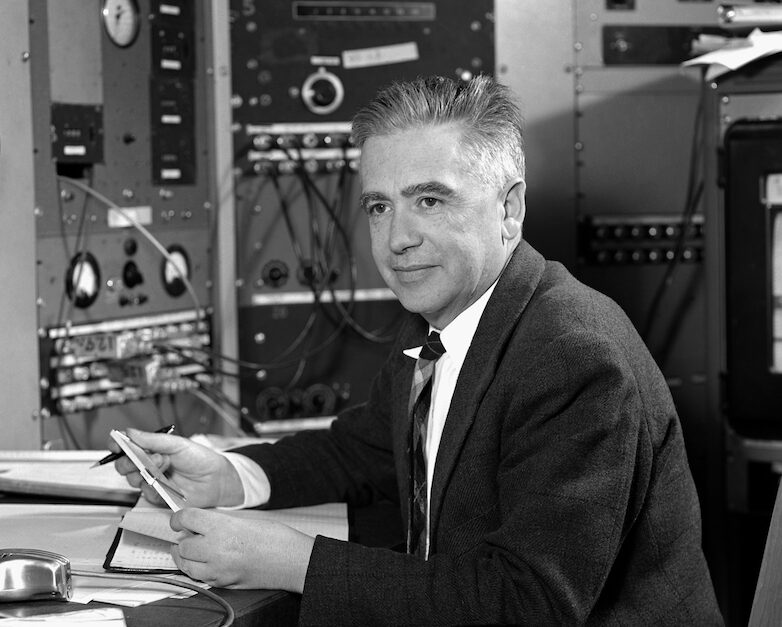Born in Tivoli (Rome) on February 1, 1905, son of Giuseppe Segrè, industrialist, and Amelia Segrè Treves. Went to school in Tivoli and Rome. Entered University of Rome as a student of engineering in 1922. Transferred to the study of physics in 1927 and took his Doctor’s degree in 1928 under Professor Fermi. His was the first Doctor’s degree conferred under the sponsorship of Professor Fermi.
Served in the Italian Army in 1928 and 1929 and entered the University of Rome as assistant to Professor Corbino in 1929. In 1930 he had a Rockefeller Foundation Fellowship and worked with Professor Otto Stern at Hamburg, Germany, and Professor Pieter Zeeman at Amsterdam, Holland. In 1932 returned to Italy and was appointed Assistant Professor at the University of Rome, working continuously with Professor Fermi and others.
In 1936 Professor Segrè was appointed Director of the Physics Laboratory at the University of Palermo and remained there until 1938.
In 1938 Professor Segrè came to Berkeley, California, first as a research associate in the Radiation Laboratory and later as a lecturer in the Physics Department. From 1943 to 1946 he was a group leader in the Los Alamos Laboratory of the Manhattan District. In 1946 he returned to the University of California at Berkeley as a Professor of Physics, and still occupies this position.
The work of Professor Segrè has been mainly in atomic physics and nuclear physics. In the first field he worked in atomic spectroscopy, making contributions to the spectroscopy of forbidden lines and the study of the Zeeman effect. Except for a short interlude on molecular beams, all his work until 1934 was in atomic spectroscopy. In 1934 he started the work in nuclear physics by collaborating with Professor Fermi on neutron research. He participated in the discovery of slow neutrons and in the pioneer neutron work carried on in Rome 1934-35. Later he was interested in radio chemistry and discovered together with Professor Perrier the element technetium; together with Corson and Mackenzie the element astatine, and together with Kennedy, Seaborg and Wahl, plutonium-239 and its fission properties. His other investigations in nuclear physics cover many subjects, e.g., isomerism, spontaneous fission, and lately, high energy physics: here he, his associates and students, have made contributions to the study of the interaction between nucleons and on the related polarization phenomena. In 1955 together with Chamberlain, Wiegand and Ypsilantis he discovered the antiproton. The study of antinucleons is now his major subject of research.
Professor Segrè has taught in temporary appointments at Columbia University, New York, at the University of Illinois, at the University of Rio de Janeiro and in several other institutions. He is a member of the National Academy of Science of the United States, of the Academy of Science at Heidelberg (Germany), of the Accademia Nazionale dei Lincei of Italy, and of other learned societies. He has received the Hofmann Medal of the German Chemical Society and the Cannizzaro Medal of the Italian Accademia dei Lincei. He is an honorary Professor of San Marcos University in Peru and is Dr. h.c. of the University of Palermo (Italy). Together with Owen Chamberlain, he received the Nobel Prize in physics for 1959 for the discovery of the antiproton. Professor Segrè is married and has three children.
[Dr. Segrè died in 1989]
© the Nobel Foundation 1960
• Biography Submitted by Dr. Chamberlain to the Nobel Committee
Dr. Owen Chamberlain, November 1955.
Owen Chamberlain was born in San Francisco on July 10, 1920. His father was W. Edward Chamberlain, a prominent radiologist with an interest in physics. His mother’s maiden name was Genevieve Lucinda Owen.
He obtained his bachelor’s degree at Dartmouth College in 1941. He entered graduate school in physics at the University of California, but his studies were interrupted by the involvement of the United States in World War II. In early 1942 he joined the Manhattan Project, the U.S. Government organization for the construction of the atomic bomb. Within the Manhattan Project he worked under Professor Emilio Segrè both in Berkeley, California, and in Los Alamos, New Mexico, investigating nuclear cross sections for intermediate-energy neutrons and the spontaneous fission of heavy elements. In 1946 he resumed graduate work at the University of Chicago where, under the inspired guidance of the late Professor Enrico Fermi, he worked toward his doctorate. He completed experimental work on the diffraction of slow neutrons in liquids in 1948 and his doctor’s degree was awarded in 1949 by the University of Chicago.
In 1948 he accepted a teaching position at the University of California in Berkeley. His research work includes extensive studies of proton-proton scattering, undertaken with Professor Segrè and Dr. Clyde Wiegand, and a important series of experiments on polarization effects in proton scattering culminating in the triple-scattering experiments with Professor Segrè, Dr. Wiegand, Dr. Thomas Ypsilantis, and Dr. Robert D. Tripp. In 1955 he participated with Dr. Wiegand, Professor Segrè, and Dr. Ypsilantis in the discovery of the antiproton. Since that time he has taken part in a number of experiments designed to determine the interactions of antiprotons with hydrogen and deuterium, the production of antineutrons from antiprotons and the scattering of pi mesons.
He is a fellow of the American Physical Society and was awarded a Guggenheim fellowship in 1957 for the purpose of doing studies in the physics of antinucleons at the University of Rome. He was appointed Professor of Physics at the University of California, Berkeley, in 1958.
In 1943 he married Beatrice Babette Copper. He has three daughters and one son.
© the Nobel Foundation 1960
